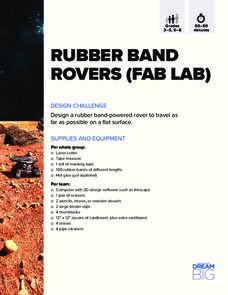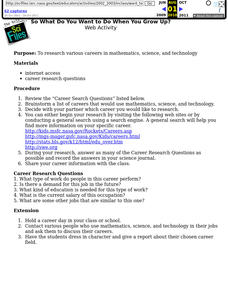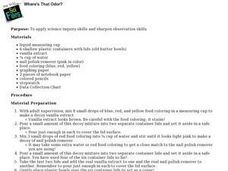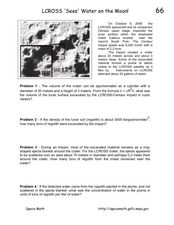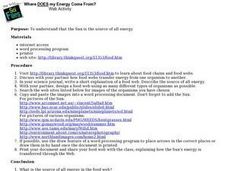DiscoverE
Rubber Band Rovers
Get your learners interested in space exploration. Groups design space rovers using design software and then build prototypes of their designs. The farther the rovers can travel, the better. The catch? The rovers must be powered by...
National Woman's History Museum
The Equal Rights Amendment
The debate over the Equal Rights Amendment continues. To better understand the controversy, class members research the history of attempts to get the amendment ratified. In addition, pairs engage in a structured academic conversation...
National Woman's History Museum
Martha Hughes Cannon: Doctor, Wife, Mother, Senator
Each state is entitled to two statues in the National Statuary Hall Collection in Washington, D.C. After reading about Utah's debate over whether or not Martha Hughes Cannon should be represented by one of their statues, individuals...
National Woman's History Museum
Getting with the Program
A seven-step lesson introduces the emergence of computer sciences and the contributions women made to the profession after World War II. Several science experiments offer pupils a hands-on learning experience that showcases parabolas,...
Curated OER
So What Do You Want to Do When You Grow Up
High schoolers research the responsibilities, required education, remuneration and demand for different of varied careers in math, science and technology. They access websites which are imbedded in this plan in order to do their research.
Curated OER
Rover Races
Students simulate driving a rover on the surface of Mars. For this space science lesson, students identify the challenges experienced by astronauts in operating a vehicle. They recommend some changes to make their 'rover' better.
Curated OER
Drop Zone! Design and Test a Probe
Students work together to develop their own parachuting probe. They test it and record the results. They simulate other experiments that are going to be carried out by the Huygens probe.
Curated OER
Time That Period!
Students analyze data received from high-energy satellites of various binary star systems' orbital periods or stellar rotation periods.
Curated OER
How Far... How Powerful
Students review some basic physics concepts about light, explore redshifted spectra and Hubble's Law, and use them to find out how far away, and how powerful, gamma ray bursts truly are.
Curated OER
How Can a Spacecraft Always Face the Sun?
Students determine the correct orbital path for a satellite that collects data about the sun so that its view of the sun never be obstructed by the Earth.
Curated OER
Cloud Database
Students research information on the types of clouds. They create a database and use a formula. They create various reports and access electronic information to obtain accurate pressure and temperature readings from the National Weather...
Curated OER
Become a Member of the Mission to Mars Team
Students examine the various jobs of the Mars Mission Team, organize them into categories and write a formal application for a position on the Mars Mission. Entries are made into the logbook and on-line Field Journals read.
Curated OER
Mission Planning: Earth/Mars Comparisons
Students compare and contrast conditions on Mars to those on our own planet, specifically, their local or regional environments. The physical characteristics, the atmosphere, and other astronomical data is considered.
Curated OER
Solar Storms
Students investigate the cycles of solar activity. They plot the solar activity and use the graph to answer a number of questions and explain the relationship between the solar storms and sunspots and the impact on earth and space travel.
Curated OER
Where's That Odor?
Students use various substances to experiment with odors and their potency. They sharpen their observational skills.
Curated OER
A Flag for Mars
Students investigate the historical use of flags on Earth, debate ownership issues for interplanetary exploration, and design a flag for Mars. The implication of placing a flag at a location forms the focus of the lesson.
Curated OER
Measuring Elevation
Students practice measuring elevation, one of the key coordinates used by astronomers. They describe how the elevation of an object is measured.
and combine compass directions and elevation to find celestial objects.
Curated OER
LCROSS 'Sees" Water on the Moon!
In this moon worksheet, students calculate information about the crater that was created by a massive impact. This worksheet has 3 problems to solve.
Curated OER
Experiment: Faster Air = Lower Air Pressure 2
Students experiment to observe air current and pressure.
Curated OER
Where Does My Energy Come From?
Learners gain an understanding that the Sun is the source of all energy. With a partner, they examine various web sites to explore food chains and food webs, later sharing their findings with the class.
Curated OER
Finding the Flu
Students work to determine when the flu is most prevalent in the United States. They gather data on their own, create calendar, charts, and graphs, analyze their findings and present them. This is a very appropriate winter lesson!
Curated OER
Earthquake Analysis
Students analyze and plot the coordinates for several recent earthquakes on a world map. They learn not only about research and geology, but about map-making and data analysis. They think of other ways to analyze the data given.
Curated OER
How Sweat Glands Cool Your Body
Students use water and rubbing alcohol to explain how sweat cools mammals' bodies. They write their findings in a journal. After a lecture/demo, students perform a simple experiment that demonstrates this phenomenae.
Curated OER
Wish You Were Here - Research Conditions on Mars
High schoolers research conditions on Mars, then create a travel brochure or presentation to attract tourists. They work in cooperative groups. Each member is assigned a different role and contribute specific information to the group's...


